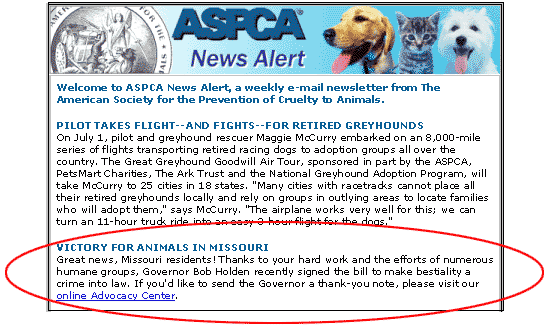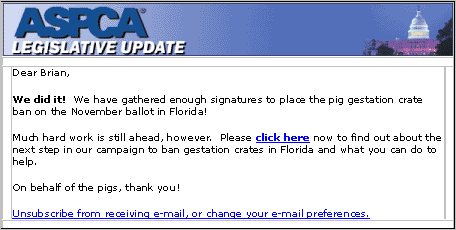|
November 2002 - Issue 16 The ASPCA and Online Advocacy: A Case Study8,000+ Emails and Faxes Sent Monthly to Legislators and OfficialsIn June 2001, The American Society for the Prevention of Cruelty to Animals (ASPCA) chose Convio™ to power its Internet infrastructure with a comprehensive online constituent relationship management (eCRM) solution. The solution enabled the organization to manage its Web site content, wage fundraising appeals, communicate through email and use the Internet in other ways to develop and sustain a loyal donor base. In December 2001, The ASPCA began using Convio for online advocacy. Before Convio, the ASPCA used a stand-alone tool for online advocacy that didn’t allow the group to: personalize Web content based upon a member's history of advocacy activism; send targeted email messages to activists; and cross-market advocacy activities to donors or fundraising appeals to activists to maximize their support. With Convio’s integrated eCRM software, The ASPCA is rapidly increasing constituent participation in advocacy, building stronger relationships with activists, and also boosting donations. Today, The ASPCA cites integration between functions (i.e., communications, advocacy, fundraising) as a key factor in the organization's online success. (For more information on how ASPCA is successfully utilizing the Internet to support its mission, read this article from the April 2002 issue of the Convio eNewsletter). Applying eCRM to advocacy involves four stages:
Outreach: ASPCA’s Email File Grows 400 Percent In 14 Months Building an email file of “opted-in” subscribers is very important for an advocacy organization because email is a fast and cost-effective method for communicating with supporters and mobilizing them to take action. In the last 12 months, The ASPCA has grown its email file from 40,000 to 175,000 email addresses. The ASPCA achieved this huge increase by capturing email addresses at every touch point with constituents. Each month, a quarter of a million "unique visitors" (i.e., each Web site visitor is counted only once, regardless of how often the individual visits the site) visit http://www.aspca.org/, driven primarily by affiliated Web sites, direct mail response forms, forwarded action alerts, other ASPCA communications, "tell-a-friend" (or viral marketing) campaigns, search engines, and other Web traffic. By providing incentives (explained in multiple places for registration on its Web site), ASPCA proactively converts 2 percent -- a significant number -- of new Web site visitors to registered subscribers. Registered constituents are treated specially -- they: are always greeted by name when they visit the Web site; receive regular email communications from the group; have access to “members-only” password-protected Web site areas as well as to the approximately 700 Web pages available to everyone; and view Web site and email content personalized for their individual interests. Through these techniques, The ASPCA interacts with its supporters in a highly personalized, relevant manner the foundation for developing strong, loyal and sustainable relationships. Motivation: Recruiting Activists, Stimulating Interest The ASPCA actively recruits registered constituents (subscribers to email communications) to become advocates and has grown its “Advocacy Brigade” (registered activists) to more than 58,000 members. At offline events, the organization cross promotes participation in advocacy by asking supporters to complete a response card for membership, which includes their email addresses. The ASPCA then can communicate regularly with these constituents and get those who are interested to opt-in as Advocacy Brigade members. Also, when a constituent registers on the Web site, The ASPCA encourages him/her to join the Advocacy Brigade through various online communications such as promotional Web site and newsletter content. The ASPCA’s Weekly Alert Newsletter regularly spotlights past, current and/or future advocacy campaigns and frequently features “calls to actions.” Fig. 1 Use communications to highlight both calls-to-action and recent victories
Action: Prompting Supporters to Act As the online Advocacy Brigade has grown, the ASPCA has conducted over 60 targeted advocacy campaigns through Convio. Through these targeted campaigns, the Advocacy Brigade now sends over 8,000 monthly messages to legislators, which is a significant increase over past activity. As of October 2002, over 110,000 targeted fax and email messages have been delivered to state and federal legislators. The ASPCA encourages supporters to act by forwarding action alerts to friend and family with the goals of getting messages delivered to decision makers and also recruiting more supporters. Loyalty: Building Enduring Relationships With Activists An advocacy-oriented nonprofit’s work does not stop at mobilizing supporters to take action (which hopefully contributes to a public policy victory). It is equally important to develop and sustain strong and loyal relationships so these constituents will continue to advocate and support the organization in other ways. Ongoing, timely, relevant and rapport-building communications are key for stewarding relationships. Email makes that easy and cost-effective. The ASPCA uses its newsletter to thank advocates for their support and provide updates on campaigns and legislative outcomes (see Fig. 1). Special, personalized emails also convey appreciation to activists, reinforce that their activity matters, keeps the organization’s mission top-of-mind, sustains involvement and strengthens relationships. Fig. 2 Email is quick and cost-effective for communicating campaign status to constituents Subject: Great News!
Additionally, nonprofits should cross-market to advocates to expand their involvement with the cause and loyalty to the organization. Typically, departments at a nonprofit do not share their supporter lists with each other so, for example, activists are not tapped to also be donors and/or volunteers and vice-versa. People who support an organization through advocacy often want to participate in other ways. The same holds true for donors, volunteers and other types of constituents. Summary The ASPCA has a strong history of tapping supporters to participate in advocacy. The group now is building on that foundation by utilizing powerful eCRM tools to expand its network of activists, mobilize them more effectively and sustain strong relationships. These supporters potentially could become donors, volunteers and other types of supporters. With a robust eCRM solution like Convio, a nonprofit uses a common technology platform across the organization and can easily share constituent information for efficient cross-marketing to keep constituents involved, active and donating.
|
|



